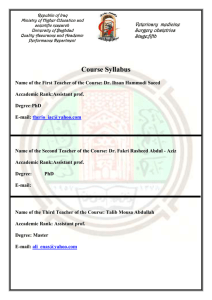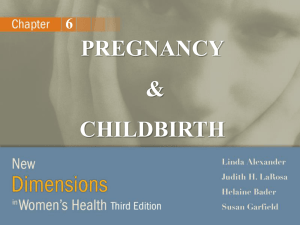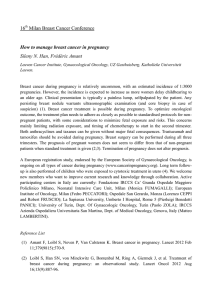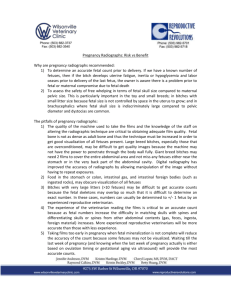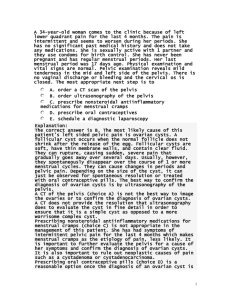Maternity and Gynecological Health
advertisement
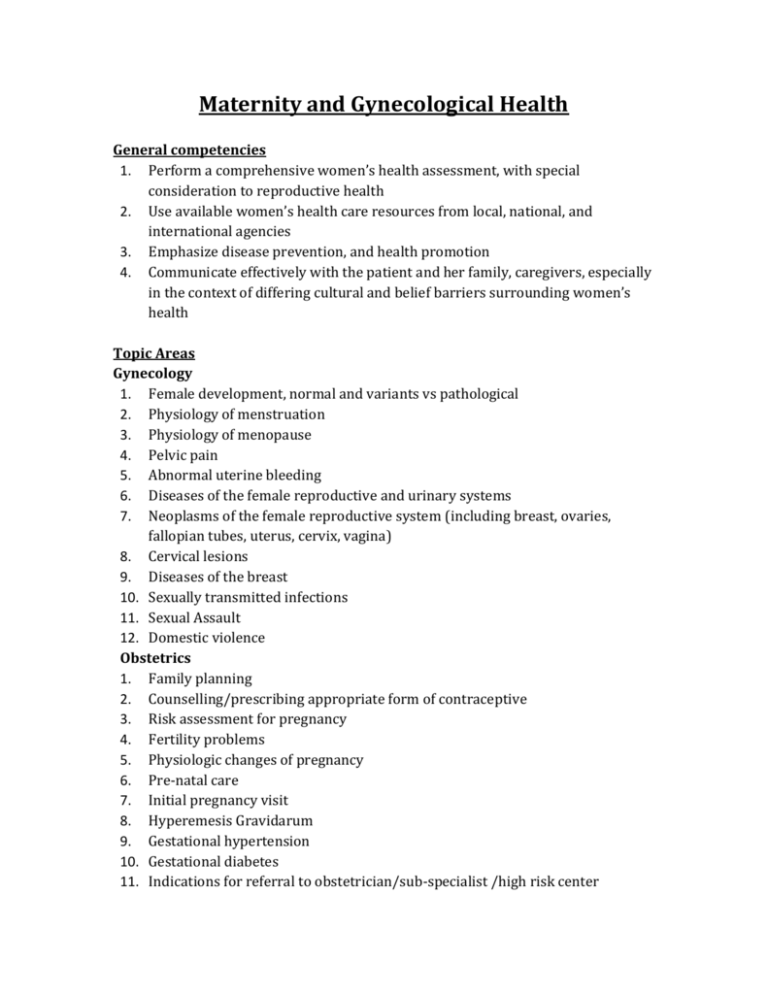
Maternity and Gynecological Health General competencies 1. Perform a comprehensive women’s health assessment, with special consideration to reproductive health 2. Use available women’s health care resources from local, national, and international agencies 3. Emphasize disease prevention, and health promotion 4. Communicate effectively with the patient and her family, caregivers, especially in the context of differing cultural and belief barriers surrounding women’s health Topic Areas Gynecology 1. Female development, normal and variants vs pathological 2. Physiology of menstruation 3. Physiology of menopause 4. Pelvic pain 5. Abnormal uterine bleeding 6. Diseases of the female reproductive and urinary systems 7. Neoplasms of the female reproductive system (including breast, ovaries, fallopian tubes, uterus, cervix, vagina) 8. Cervical lesions 9. Diseases of the breast 10. Sexually transmitted infections 11. Sexual Assault 12. Domestic violence Obstetrics 1. Family planning 2. Counselling/prescribing appropriate form of contraceptive 3. Risk assessment for pregnancy 4. Fertility problems 5. Physiologic changes of pregnancy 6. Pre-natal care 7. Initial pregnancy visit 8. Hyperemesis Gravidarum 9. Gestational hypertension 10. Gestational diabetes 11. Indications for referral to obstetrician/sub-specialist /high risk center 12. 13. 14. 15. 16. 17. 18. 19. 20. 21. 22. 23. 24. 25. 26. 27. Voluntary termination of pregnancy Fetal assessment during pregnancy and delivery Ectopic pregnancy Physiology of labour, delivery Analgesia/anaesthesia for labour and delivery Intra-partum problems (i.e. hypertension, pre-eclampsia, fever, infection, fetal status, shoulder dystocia, placental abruption/accreta) Pre-term labour Induction of delivery Caesarian section Obstetric emergencies Neonatal resuscitation Post-partum care Post-partum hemorrhage, endometritis, etc. Lactation Effective use of multi-disciplinary team (nutritionist, midwife, nurse, lactation consultant, etc.) Care of the normal newborn, and common neonatal problems For each topic area 1. Epidemiology 2. Anatomy 3. Pathophysiology/Etiology 4. Risk factors 5. History and physical exam 6. Diagnostic Tests 7. Differential diagnosis 8. Management 9. Psychosocial implications Highlighted teaching points 1. Anatomy a. Normal anatomy and variants of female reproductive and urinary systems b. Normal anatomy and variants of pregnancy (placental anatomy, fetal development) 2. History and physical exam a. Gynecology: Screening physical exam , breast exam, pelvic exam b. History/physical exam for suspicion of sexual assault/domestic violence c. Obstetrics 3. 4. i. Initial pregnancy visit ii. Fetal assessment during pregnancy and delivery iii. Physical exam of the newborn Diagnostic tests (including indication for): a. Gynecology i. Vaginal and cervical cytology ii. Colposcopy iii. Cervical biopsy iv. Endometrial biopsy v. Microscopic diagnosis of urine and vaginal smears b. Diseases of the breast i. Mammography ii. Breast lump aspirate/biopsy c. Obstetrics i. Diagnosis of pregnancy (b-HCG – urine/blood) ii. Fertility problem work-up iii. Ectopic pregnancy: ultrasound, serial b-HCG d. Fetal monitoring i. Ultrasound ii. Non-stress test Management (including indications for) a. Cervical polypectomy b. Endometrial biopsy c. Cryosurgery and cautery for benign disease d. Bartholin duct cyst management e. Family planning and contraception i. Oral contraceptive counseling and prescribing ii. Intrauterine contraceptive device counseling, insertion and removal iii. Diaphragm fitting and counseling iv. Insertion and removal of subcutaneous contraceptive implants and counseling v. Injectable long term contraceptives and counseling f. Pregnancy i. Pre-conceptual counseling ii. Initial pregnancy visit iii. Risk assessment g. Management of labor i. Pudendal and local block anesthesia ii. Induction of labor iii. iv. 5. Internal fetal monitoring and amnioinfusion Common intrapartum problems (e.g., hypertension, mild preeclampsia, fever, infection, nonreassuring fetal status, unanticipated shoulder dystocia, manual removal of placenta) v. Normal cephalic delivery (including use of vacuum extraction and outlet forceps) vi. Episiotomy and repair (including third-degree lacerations) vii. Emergency breech delivery viii. Common postpartum problems (e.g., hemorrhage, endometritis) ix. Caesarian section x. Vaginal delivery after previous Caesarian section h. Neonatal resuscitation Psychosocial implications of gynecological/ maternity health a. Special consideration to sexual abuse and domestic violence References: 1. American Academy of Family Physicians. (2008). Recommended Curriculum Guidelines for Family Medicine Residents, Maternity and Gynecologic Care (Reprint No. 278), Leawood, Kansas.







